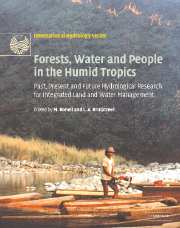 Forests, Water and People in the Humid Tropics
Forests, Water and People in the Humid Tropics from Part V - Critical appraisals of best management practices
Published online by Cambridge University Press: 12 January 2010
INTRODUCTION
Land clearance in the humid tropics needs to be considered very carefully. This chapter is an attempt to put the brakes on, or at least to insert a filter of conditions, so that any clearing does not have adverse, or only minimally adverse, effects on soil and water resources and processes. It follows on from the many precautionary statements, some even labelled ‘guidelines’ that have appeared since the early 1970s. As a matter of forest land policy, setting the framework for planning, there should be a thorough examination of alternatives to clearing more land. Poore and Sayer (1987) put it succinctly:
‘Before deciding to modify or transform untouched areas, every consideration should be given to alternatives. This may include adapting areas that have already been changed, to more productive uses, for example, using savannas for pine plantations. Alternatively, it may involve intensification of existing uses, or using areas for more than one purpose, if these are compatible.’
The high cost (in both ecological and economic terms) of any new land development dictates that the starting point in planning should be a detailed analysis of alternatives including possibilities of intensification on land already converted (Hansen and Dickensen, 1987). Similarly, there is an early need for an assessment of the capability and suitability of an area under planning scrutiny for the proposed use if alternatives are not available. Such an assessment, using well-developed procedures (e.g. Carpenter, 1981; FAO, 1974), if rigorously carried out may abort a proposed conversion.
To save this book to your Kindle, first ensure no-reply@cambridge.org is added to your Approved Personal Document E-mail List under your Personal Document Settings on the Manage Your Content and Devices page of your Amazon account. Then enter the ‘name’ part of your Kindle email address below. Find out more about saving to your Kindle.
Note you can select to save to either the @free.kindle.com or @kindle.com variations. ‘@free.kindle.com’ emails are free but can only be saved to your device when it is connected to wi-fi. ‘@kindle.com’ emails can be delivered even when you are not connected to wi-fi, but note that service fees apply.
Find out more about the Kindle Personal Document Service.
To save content items to your account, please confirm that you agree to abide by our usage policies. If this is the first time you use this feature, you will be asked to authorise Cambridge Core to connect with your account. Find out more about saving content to Dropbox.
To save content items to your account, please confirm that you agree to abide by our usage policies. If this is the first time you use this feature, you will be asked to authorise Cambridge Core to connect with your account. Find out more about saving content to Google Drive.